|
|
Johannes Brahms (Composer, Arranger) |
|
Born: May 7, 1833 - Hamburg, Germany
Died: April 3, 1897 - Vienna, Austria |
|
Johannes Brahms was a German composer of Romantic music, who predominantly lived in Vienna, Austria. |
|
Life |
|
Johannes Brahms was born in Hamburg. His father, Johann Jakob Brahms, came to Hamburg from Schleswig-Holstein seeking a career as a town musician. He was proficient on several instruments but found employment mostly as a horn player and double bassist. He married Christiane Nissen, a seamstress, who was considerably older than him. They lived in the poor Gängeviertel district of the city, near the docks. Johann Jakob gave his son his first musical training. Brahms showed early promise on the piano (his younger brother Fritz also became a pianist) and helped to supplement the rather meager family income by playing the piano in restaurants and theaters, as well as by teaching. Although it is a widely-told tale that Brahms had to play the piano in bars and brothels, recent research, for example that by Kurt Hoffman1, suggests that this is probably false. For a time, he also learned the cello, although his progress was cut short when his teacher absconded with Brahms's instrument. His piano teachers were first Otto Cossel and then Eduard Marxsen, who had studied in Vienna with Ignaz Seyfried (a pupil of Mozart) and Carl von Bocklet (a close friend of Schubert). The young Brahms gave a few public concerts in Hamburg, and though he did not become well known as a pianist he made some concert tours in the 1850's and 1860's and in later life frequently participated in the performance of his own works, whether as soloist, accompanist, or participant in chamber music. Notably he gave the premieres of both his Piano Concerto No. 1 in 1859 and his Piano Concerto No. 2 in 1881. In his early teens he began to conduct choirs and eventually became an efficient orchestral conductor.
Johannes Brhams began to compose quite early in life (we know of a piano sonata he played or improvised at the age of 11), but his efforts did not receive much attention until he went on a concert tour as accompanist to the Hungarian violinist Eduard Reményi in April-May 1853. On this tour he met Joseph Joachim at Hanover, and went on to the Court of Weimar where he met Franz Liszt, Cornelius and Joachim Raff. According to several witnesses of Brahms's meeting with F. Liszt, at which Liszt performed Brahms's own op.4 Scherzo at sight, Reményi was offended by Brahms' failure to praise F. Liszt's Sonata in B minor wholeheartedly (Brahms fell asleep during a performance of the recently-composed work), and they shortly afterwards parted company, although it was not clear as to whether F. Liszt felt offended or otherwise. Joachim had given Brahms a letter of introduction to Robert Schumann, however, and Brahms walked to Düsseldorf, arriving on September 30 and being welcomed into the Schumann family. Robert Schumann, amazed by the 20-year-old's talent, published an article 'Neue Bahnen' (New Paths) in the journal Neue Zeitschrift fur Musik alerting the public to the young man whom he claimed was 'destined to give ideal expression to the times'. This pronouncement was received with some scepticism outside Robert Schumann's immediate circle, and may have increased the naturally self-critical Brahms's need to perfect his works and technique. While he was in Düsseldorf Brahms participated with Robert Schumann and Albert Dietrich in writing the jointly-composed 'F-A-E' Sonata for Joachim. He became very attached to Robert Schumann's wife, the composer and pianist Clara Schumann, 14 years his senior, with whom he would carry on a lifelong, emotionally passionate, but (as far as is known) always platonic relationship. Brahms never married, despite strong feelings for several women and despite entering into an engagement, soon broken off, with Agathe von Siebold in Gottingen in 1859. After Robert Schumann's attempted suicide and subsequent encarceration in a mental sanatorium near Bonn in February 1854, Brahms was the main go-between between Clara and her husband, and found himself virtually head of the household.
After Robert Schumannís death at the sanatorium in 1856 Brahms divided his time between Hamburg, where he formed and conducted a ladiesí choir, and the principality of Detmold, where he was court music-teacher and conductor. He first visited Vienna in 1862, staying there over the winter, and in 1863 was appointed conductor of the Vienna Singakademie. Though he resigned the position the following year he based himself increasingly in Vienna and soon made his home there, though he toyed with the idea of taking up conducting posts elsewhere. From 1872 to 1875 he was Director of the concerts of the Vienna Gesellschaft der Musikfreunde; afterwards he accepted no formal position. He refused an Honorary Doctorate of Music from Cambridge University in 1877 (he was afraid of being lionized in England, where his music was already very popular) but accepted one from the University of Breslau in 1879, composing the Academic Festival Overture in response.
He had been composing steadily throughout the 1850s and 60s, but his music had evoked divided critical responses and the First Piano Concerto had been badly received in some of its early performances. His works were labelled old-fashioned by the 'New German School' whose principal figures included F. Liszt and Wagner. Brahms in fact admired some of Wagner's music and admired F. Liszt as a great pianist, but in 1860 he attempted to organize a public protest against some of the wilder excesses of their music. His manifesto, which was published prematurely with only three supporting signatures, was a ludicrous failure and he never engaged in public polemics again. It was the premiere of Ein deutsches Requiem, his largest choral work, in Bremen in 1868 that confirmed Brahms's European reputation and led many to accept that he had fulfilled Robert Schumannís prophecy. This may have given him the confidence finally to complete a number of works that had been wrestled with over many years, such as the cantata Rinaldo, his first String Quartet, Third Piano Quartet and, most notably, his First Symphony; this appeared in 1876, though it had been begun (and a version of the first movement seen by some of his friends) in the early 1860s. The other three symphonies then followed in fairly rapid succession (1877, 1883, 1885). From 1881 he was able to try out his new orchestral works with the court orchestra of the Duke of Meiningen, whose conductor was Hans von Bülow.
Brahms frequently traveled, both for business (concert tours) and pleasure. From 1878 onwards he often visited Italy in the springtime, and usually sought out a pleasant rural location in which to compose during the summer. He was a great walker and especially enjoyed spending time in the open air, where he felt that he could think more clearly.
In 1890, the 57-year-old Brahms resolved to give up composing. However, as it turned out, he was unable to abide by his decision, and in the years before his death he produced a number of acknowledged masterpieces. His admiration for Richard Muhlfeld, clarienttist with the Meiningen orchestra, caused him to compose the clarinet quintet Op.115 (1891), clarinet trio Op.114 (1891) and the two clarinet sonatas Op. 120 (1894). He also wrote several cycles of piano pieces, Opp.116-119 and the Four Serious Songs (Vier ernste Gesänge) Op. 121 (1896).
While completing the Op. 121 songs Brahms fell ill of cancer (sources differ on whether this was of the liver or pancreas). His condition gradually worsened and he died on April 3, 1897. Brahms is buried in the Zentralfriedhof in Vienna.
Although Brahms may be often regarded as one of the last bastions of the Romantic Period, he was a champion of form and logic within his works in contrast to the opulence and excesses of many of his contemporaries. Alongside Anton Bruckner, Brahms was perhaps the major practitioner of the symphony during the latter half of the 19th century and his works in this genre certainly paved the way for others such as Gustav Mahler and Jean Sibelius. Though he was diametrically opposed to Wagner during his lifetime, it is incorrect to characterize Brahms as a reactionary. His output was sometimes equally bold in harmony and expression, prompting Arnold Schoenberg to write his important essay entitled "Brahms the Progressive" which paved the way for the revaluation of Brahms's reputation in the 20th century. It is (perhaps) significant that Brahms himself had considered giving up composition at a time when all notions of tonality were being stretched to their limit and that further expansion would seemingly only result in the rules of tonality being broken altogether. It should be noted, however, that he offered substantial encouragement to A. Schoenberg's teacher Alexander Zemlinsky and was apparently much impressed by an early quartet of A. Schoenberg's. |
|
Works |
|
Brahms wrote a number of major works for orchestra, including four symphonies, two piano concertos, a Violin Concerto, a Double Concerto for violin and cello, and the large choral work A German Requiem (Ein deutsches Requiem). The last is notable in not being a traditional, liturgical requiem (Missa pro defunctis), but a setting of texts which Brahms selected from the Luther Bible. Brahms was also a prolific composer in the theme and variation form, having notably composed the Variations and Fugue on a Theme by Handel, Paganini Variations, and Variations on a Theme by Joseph Haydn, along with other lesser known sets of variations.
Brahms also wrote a great deal of work for small forces. His many works of chamber music form part of the core of this repertoire, as does his solo piano music. Brahms is also considered to be among the greatest of composers of lieder, of which he wrote about 200. He also wrote a set of chorale preludes for organ shortly before his death, which have become an important part of the standard organ repertoire.
Brahms never wrote an opera, nor did he ever write in the characteristic 19th century form of the tone poem. Brahms strongly believed in absolute music, that is, music that does not rely upon a concrete scene or narrative as the tone poem does.
Despite his (deserved) reputation as a composer of great seriousness and of large, complex musical designs, in his lifetime some of Brahms's most widely-known and commercially successful compositions were small-scale and popular in intention, aimed at the then-large market of domestic music-making. These included his Hungarian Dances, the Waltzes op.39 for piano duet, the Liebeslieder Waltzes for vocal quartet and piano, and some of his many songs, notably the Wiegenlied, op.49 no.4 (published in 1868). This last item was written (to a folk text) to celebrate the birth of a son to Brahms's friend Bertha Faber, and is known throughout the English-speaking world as 'Brahms's Lullaby'. |
|
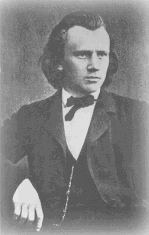
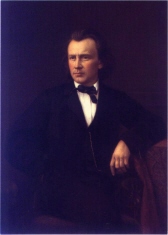
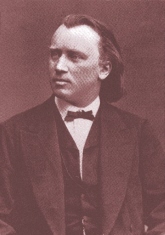
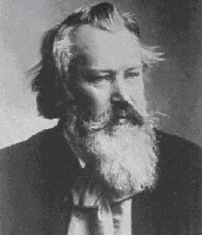
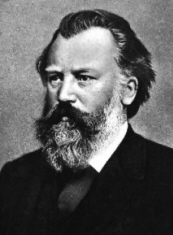
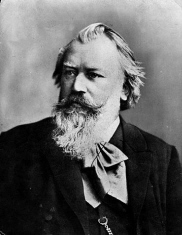
|
|
More Pictures |
|
Source: Wikipedia Website
Contributed by Aryeh Oron (February 2006) |
|
Johannes Brahms : Short Biography | Piano Transcriptions: Works | Recordings | Other Arrangements/Transcriptions: Works | Recordings | Brahms & Bach - Discussions |
|
Use of Chorale Melodies in his works |
|
Title |
Chorale Melody |
Year |
|
Es ist das Heil uns kommen her, unaccompanied motet for 5 voices, Opus 29 no. 1). A four-part chorale is succeeded by an elaborate fugal variation on the chorale melody |
Es ist das Heil uns kommen her |
before 1860 |
|
In the triptych of Motets op. 110 a central four-part cantional hymn deriving from the chorale Es ist genug is flanked by two pieces for double choirs |
Es ist genug |
|
|
Warum ist das Licht gegeben , a-cappella Motet, op.74 no.1 |
Mit Fried und Freud ich fahr dahin |
1877 |
|
O Gott, du frommer Gott , Chorale Prelude for Organ, Op. posth. 122/7 |
O Gott, du frommer Gott |
1896 |
|
2 Chorale Preludes for Organ on O Welt, ich muß dich lassen, Op. 122 Nr. 3 & 11 Opus posthumous |
O Welt, ich muß dich lassen |
1896 |
|
O, wie selig seid Ihr doch, Ihr Frommen , Choral prelude for organ, Op. posth. 122/6 |
O wie selig seid ihr doch, ihr Frommen |
1896 |
|
Schmücke dich, o liebe Seele , Chorale Prelude for Organ Op. 122 No. 5 |
Schmücke dich, o liebe Seele |
1896 |
|
Links to other Sites |
|
Johannes Brahms
Johannes Brahms (Classical Music Pages)
Johannes Brahms (Wikipedia)
Brahms, Johannes (1833 - 1897) (Naxos)
Island of Freedom - Johannes Brahms
Johannes Brahms (Classical Net)
Classical Music Archives: Brahms Biography
The Symphony: Johannes Brahms
Johannes Brahms: Composer
Essentials of Music: Brahms
BBC - Music / Profiles: Johannes Brahms
Johannes Brahms (IPL)
Johannes Brahms Biography - Traditional Music, Romantic Passion (Favorite Classical Composers) |
Johannes Brahms (Karadar)
Johannes Brahms - an overview of the classical composer
Johannes Brahms: Welcome to the American Brahms Society
Organ Composers: Johannes Brahms
Clara Schumann and Johannes Brahms
Johannes Brahms (CPDL)
Works by Johannes Brahms (Project Guttenberg)
Johannes_Brahms (Icking Music Archive)
Brahms at the Piano
Brahms page at AllMusic
Der Tod und Johannes Brahms
Brahms cylinder recordings (University of California)
Johannes Brahms (zZounds) |
|
Bibliography |
|
Johannes Brahms: Life and Letters, ISBN 0198162340 by Brahms himself, edited by Styra Avins, translated by Josef Eisinger (1998). A biography by way of comprehensive footnotes to a comprehensive collection of Brahms's letters (some translated into English for the first time). Elucidates some previously contentious matters, such as Brahms's reasons for declining the Cambridge invitation.
Brahms, His Life and Work, by Karl Geiringer, photographs by Irene Geiringer (1987, ISBN 0306802236). A bio and discussion of his musical output, supplemented by and cross-referenced with the body of correspondence sent to Brahms.
Charles Rosen discusses a number of Brahms's imitations of Beethoven in Chapter 9 of his Critical Entertainments: Music Old and New (2000; Cambridge, MA: Harvard University Press, ISBN 0674177304).
Brahms by Malcolm MacDonald is a biography and also discussion of virtually everything Brahms composed, along with chapters examining his position in Romantic music, his devotion to Early Music, and his influence on later composers. (Dent 'Master Musicians' series, 1990; 2nd edition Oxford, 2001, ISBN 019816484)
Johannes Brahms: A Biography, by Jan Swafford. A comprehensive (752 pages) look at the life and works of Brahms. (1999; Vintage, ISBN 0679745823)
Late Idyll: The Second Symphony of Johannes Brahms, by Reinhold Brinkmann, translated by Peter Palmer. An analysis of Symphony No.2 and meditation of its position in Brahms's career and in relation to 19th-century ideas of melancholy. (1995, Harvard, ISBN 0674511751) |
|
|